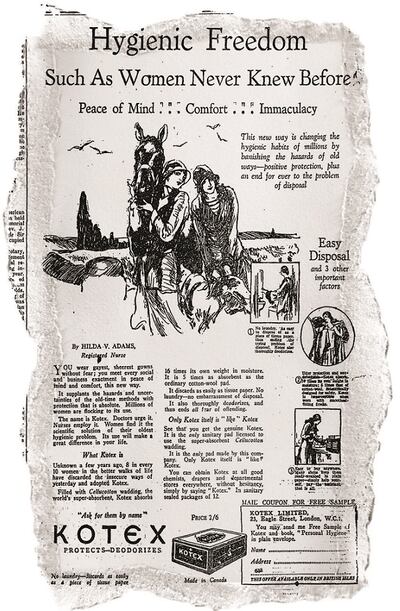It may surprise modern readers to know that 19th-century women could peruse this paper and find advertisements for both sanitary products and medications for menstrual complaints.

One of the earliest, and oddest, “treatments”, publicised in 1859, were Pulvermacher’s Patent Medico-Galvanic Chain Bands, worn under the garments (for the self-application of Local Galvanism). Among their vast range of alleged “cures” was: “In amenorrhoea, or Torpidity of the Womb, considerable benefit is obtained by passing a current through the pelvis from the sacrum to the pubis”.
More than 20 years later, Harness’ Electropathic Belt, promised to renew “exhausted nerve force”. In her testimonial for “Menstrual Irregularities”, Mrs J Hawkey, announced: “mine is a remarkable recovery”.
Even the religious recognised the toll menstruation could levy
Ads for the first disposable Southall’s Sanitary Towels (patented) began to appear in the mid-1880s. An “eminent Medical Practitioner” is quoted, describing them as “one of the most valuable inventions for woman’s comfort I have seen in the quarter of a century I have been in practice”. In1889, ladies visiting the Paris Exhibition and the continent were even advised where they could purchase Southall’s Towels.
Initially “supplied by Ladies and Children’s Outfitters”, including Switzer & Co, Grafton Street, by 1890 the towels were on sale in chemists, and a patented “combined Stocking and Towel Suspender” was available for “the convenience and comfort of ladies”. In 1891, Southall’s also offered “Something New for Ladies” – a medium towel, bringing its range to four sizes.

By 1908, Kotex had also arrived, and began offering “hygenic freedom”, and “peace of mind . . . comfort . . . immaculacy”.
Advice and advertisements for combatting menstrual pain and “irregularities” featured in the paper’s pages throughout the second half of the 19th and early 20th centuries. During the 1860s, Holloways Pills described their “gentle alterative properties” as “The Female’s Friend”.
Poisoning
However, other prescriptions were not so friendly. A report in 1865 recounted the “Salisbury Poisoning Case”, in which a young surgeon’s assistant was charged with poisoning his 19-year-old sweetheart. The young man committed suicide in prison before trial, but left details of the prescription he had prepared for her “obstinate menstruation and Chlorosis” which included “strychnia”. The dose was only fatal, he claimed, because she took an extra pill against his instructions.
Viatpoise in the 1890s cured "ladies of all pains" while other afflictions of menstruating women, including anaemia and chlorosis – "green sickness" – were also featured. The proposed cures, however, often came with cautions. Bravais felt the need to market itself in 1879 as the iron "that never blackens the teeth", while in 1891 a report from France told of a patient with chlorosis being administered a transfusion of goat's blood.

Even the religious recognised the toll menstruation could levy. In 1902, St Vincent de Paul’s elixir authorised by the Sisters of Charity in Paris was advertised weekly, offering a 20-day cure for anaemia, chlorosis and “diseases of women”.
Cuticura products, meanwhile, have laid claim to many curative features for more than 150 years. In 1903, they proclaimed: “Too much stress cannot be placed on the great value of Cuticura Soap, ointment and pills in the antiseptic cleansing of the mucous surfaces and of the blood and circulating fluids, thus affording pure, sweet and economical local and constitutional treatment for weakening discharges, ulcerations, inflammations, itchings, irritations, relaxations, displacements, pains and irregularities peculiar to females.”
In 1904, Vironics was just one of the “blood medicines” recommending itself to “females of all ages”, and by 1912, Horton’s Benedict Pills promised to “correct all irregularities, also cure anaemia”. A free sample, with an “improved Sanitary Towel and interesting booklet” could be had by writing to Horton and Co Chemists (Chief Dispenser from the Birmingham Lying-in Hospital). In 1913, readers were assured that “Widow Welch’s Female Pills” are “ordered by specialists for the cure of all female complaints . . .”

‘Indecent advertising’
However, in 1927, “The Committee on Evil Literature appointed by the Free State” decreed that the Indecent Advertisements Act should be revised to include with the definition of “indecent advertising” any document, picture or printed matter referring to the “prevention or removal of irregularities in menstruation”.
Moving through the century, a 1959 column by the paper’s medical correspondent was dedicated to the topic of menstruation. In “A Vicious Cycle”, our correspondent muses it would be interesting “to know how much human misery and how many broken marriages might be traced to the collection of symptoms known as ‘the premenstrual syndrome’.” Men, he insists, should be informed of the facts, “to make them more understanding, of their womenfolk’s bewildering changes of mood” and “to let them know that the disorder was now curable”.
Older readers, meanwhile, may recall coverage of the 1963 attempt by French officials to abolish a number of women’s Olympic events, including fencing, canoeing and some athletic events. Their reasoning: “inappropriate exercises during puberty, menstruation and maternity could lead to serious disorders”. The same officials also recommended that if not abolished, “ungraceful” events, including women’s bicycle racing and weight-putting, should not be held in public! The date of this article was not April 1st.
- This is part of a series looking at the archives of The Irish Times concerning health.
[ Sleeping secrets: undress in the dark, walk around the room and lie east-to-westOpens in new window ]





















